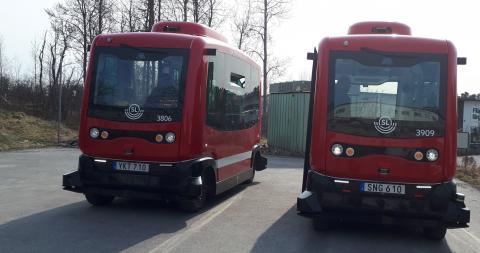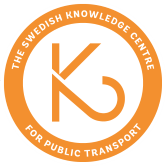Article highlighted
Smart mobility in public transport affects governance and collaboration

− The starting point was to explore and understand what happens in a specific context where smart mobility is introduced, says Kelsey Oldbury, research assistant at K2 and VTI (the Swedish National Road and Transport Research Institute).
Kelsey has studied the processes of governance and planning of public transport in light of the changing transport sector where new smart mobility services are under development and presented the study in her licentiate thesis this February.
In two pilot projects the public transport authority at Region Stockholm (the county council), the private bus company Nobina and the local municipality of Järfälla have implemented new mobility solutions with driverless shuttles and MaaS. These two pilot projects are part of a broader collaboration between these three actors, “Modern Mobility in Barkarbystaden”, based on both developing public transport early in the process of a large-scale urban development, and to test and develop new concepts and new techniques. The municipal innovation company Barkarby Science and bus operator Nobina´s innovation company Nobina Technology have been important in the process leading to the two pilot projects.
Buses and MaaS interact with public transport in different ways
− The work connected to Barkarbystaden is interesting as both projects illuminate the encounter between smart mobility and public transport, as well as the difference between autonomous buses and MaaS, both in the smart mobility spectra but different in concepts and techniques, says Kelsey.
The pilot project with the autonomous buses connected to formal documents, roles and processes for public transport supply while MaaS showed how the relations changed between the bus operator and the public transport authority as part of the app that was created. In that context public transport is included among several mobility services.
− With that in mind, the developments in Barkarbystaden give us insights how new smart mobility services affect both planning and governance of public transport, as well as the collaboration between authorities and suppliers, says Kelsey.
As the region and the bus operator are already actors in the transport sector, they had started to develop ideas about MaaS and their position in relation to the concept. Early on in 2017 Nobina Technology had a suggestion about testing different MaaS pilots in the Stockholm area. This initial idea for a pilot was then integrated in the bigger collaboration project in Barkarbystaden.
− I would say that this form of MaaS is constructed according to the structures and ideas of the transport sector. The service was launched with specific mobility services for both Barkarbystaden and the Stockholm region. Therefore, as I discuss in my thesis, it was more difficult for the municipal authorities to relate to MaaS and take a stand on a platform that was also launched on a regional level. As local authorities have more responsibility and impact on building processes, they would potentially construct a MaaS service differently, for example integrating it with housing development.
Insights about future collaboration
− A lot of things are happening at the same time. It is, for example, interesting to follow how the different pilot projects in Barkarbystaden have shown how smart mobility contains so many dimensions, mainly because it is actually an umbrella term. Another interesting aspect is the overarching collaboration between the actors involved, which is a relatively new way of working. The three actors already had established contact and relations with each other, but collaboration around these pilots and the development of new services has been a new meeting point. Something which has also led to new insights into how to potentially collaborate in the future, says Kelsey.
Another thing made clear was how the actors´ different roles affected the development of the collaboration and the pilots. The regional public transport authority and Nobina are actors focused on transport, in comparison with the municipal authority whose mission encompasses both transport planning, as well as the many other municipal responsibilities such as healthcare, schools and housing.
− This case gives us insights into the role of the bus operator, and the way in which they are developing their position as a provider of autonomous vehicles in public transport and as an actor responsible for a MaaS service. Smart mobility is often dominated by new private enterprises and new services. The bus operator is therefore an interesting actor, as they are formally a private actor, but at the same time responsible for a public service commissioned by a regional public transport authority. Therefore their role falls at an interesting intersection of private and public, says Kelsey.
The project ”Modern mobility in Barkarbystaden” ran between 2018-2020 but the development of the pilots launched continues. But what Kelsey Oldbury sees in her study is that the project raises questions about the role of the pilot project in relation to governance of smart mobility in public transport.
− The pilot project is often used as a test site for reshaping or changing the mobility system, and as a strategy or tool for developing knowledge and launching new services. However, if smart mobility is the future – or an important part of the future – then it is important that municipal, regional and national levels of governance discuss strategies and their approach to smart mobility at a broader level beyond their engagement in different pilot projects. This is of course a complex balancing act, but at the same time it is important that public actors have the tools and the knowledge they need in order to ensure that smart mobility developments contribute to public goals, Kelsey concludes.
Kelsey Oldbury is a research assistant at K2 and VTI (the Swedish National Road and Transport Research Institute). She presented her licentiate thesis at KTH (the Royal Institute of Technology) on February 2021.
Read the thesis: Public transport meets smart mobility
